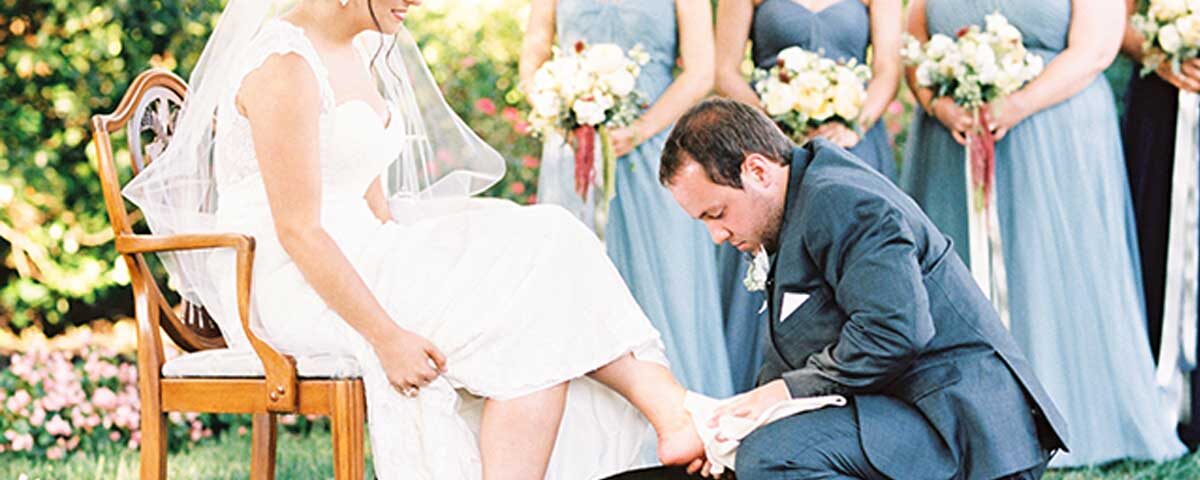
How Do You Know If You’re Ready To Get Engaged?
November 19, 2024
Steps to planning your wedding.
November 19, 2024Wedding Traditions Around the World
There are many strange wedding traditions in the world. The Jews smash a glass at a wedding to commemorate the destruction of the temple in Jerusalem, and in some countries people throw shoes at the wedding car as it leaves, as it is supposed to bring good luck. So, where do some of our wedding traditions come from?
Wedding Rings and Their Origins
Wedding rings originated in Egypt and were only given to the bride as a symbol of ownership by her husband but thanks to some progress, the rings are now exchanged to show that the ownership goes both ways! The Sicilians were responsible for adding the diamond to the wedding ring, as they believed the diamond was forged in a fire of love, but this was really popularised by Archduke Maximilian of Austria when he married Mary of Burgundy in 1477. The father giving away the bride was linked to this idea of ownership, so we have not progressed quite that far. Wedding rings go on the fourth finger because people believed that there was a vein called the vena amoris that ran from the fourth finger directly to the heart.
The Honeymoon Tradition
These days the honeymoon is seen as a romantic getaway for the bridal couple but the tradition actually comes from a time when men would kidnap women to marry, and then would hide for a month after the wedding so that the woman’s family would stop looking for her. The name comes from the Norse tradition of drinking honeyed wine for a month after the wedding.
Bridal Veil and Its Ancient Purpose
The bridal veil is a leftover from ancient times when we had arranged marriages, and the groom sometimes did not know what his wife would look like before the wedding day. In Roman times women also wore veils because they believed this helped to ward off evil spirits.
Veils are one of the most recognizable symbols in ancient wedding traditions, reflecting how deeply people feared bad omens and unseen spirits. These customs were a central part of ancient wedding ceremonies, where brides were often heavily covered for protection and secrecy. Even today, veils continue to be part of many cultures, blending modern romance with the echoes of ancient marriage customs that shaped the ritual.
The Origin of the Bridal Bouquet
The bride’s bouquet has disputed origins depending on where you are in the world. In eastern Europe the bouquet originally consisted of mint and marigold to ward off evil spirits. In western Europe the bouquet had a more practical purpose. People in the Middle Ages only bathed a few times a year, and the traditional first bath after winter was in May, so people got married in May, just after the first bath, and carried flowers to smell better.
The use of flowers in weddings reflects both practical needs and symbolic beliefs. While in Europe bouquets often addressed hygiene, in other regions they carried strong connections to wedding traditions origins and spirituality. In some wedding traditions in USA, the bridal bouquet evolved to represent fertility and prosperity. Across cultures, flowers remain a meaningful element in weddings, carrying with them a mix of practicality, beauty, and protection against negative forces.
White Wedding Dresses
White wedding dresses have nothing to do with purity but date from the wedding of Queen Victoria in 1840. Before that date people got married in red dresses (they still do in most of the non-western world), but because washing was so hard in those days, having an immaculate white dress was a symbol of ostentatiousness, of wealth, and this is what made the white dress popular.
This change in bridal fashion shows how traditions can be redefined by cultural icons. Queen Victoria’s choice set a new standard that quickly spread to Europe and the wedding traditions in USA. While many cultures still favor red or gold, white gowns became a symbol of modernity in the West, showing how ancient marriage customs could transform over time into global standards. The white dress continues to be one of the strongest symbols of weddings, blending history with status and style.
If you are looking for some of the more special places to get married in the USA you can always look for more information in our website
Bridesmaids and Best Man
Bridesmaids date from the Roman times, when they were asked to dress similarly to the bride to confuse exes and evil spirits. Basically, they were decoys to confuse kidnappers and keep you safe from the spirit world. The best man, on the other hand, literally was the “best man”. He was supposed to be the biggest, toughest friend you had, who could keep you safe from someone who didn’t want you marrying the bride.
This practice highlights how marriage was once as much about safety as celebration. In ancient wedding ceremonies, the presence of bridesmaids was a protective measure, while the best man’s strength ensured the union went ahead. Some cultures, like Ireland wedding traditions, also used attendants and community members to shield couples from bad luck. These roles, while symbolic today, remind us how deeply wedding traditions origins are tied to protection, strength, and community support.
Wedding Bells and Carrying the Bride
The tradition of wedding bells originated in Ireland, where bells were thought to ward off evil spirits. This fear of evil spirits was also why the husband carried his bride over the threshold, because for some reason, brides were susceptible through their feet.
These practices reflect some of the most symbolic Ireland wedding traditions, where sound and ritual were used to protect newlyweds. Bells were common in ancient wedding ceremonies because communities believed their vibrations created a shield of good fortune. Carrying the bride into her new home was another protective gesture, deeply tied to wedding traditions origins, showing how physical actions were seen as powerful defenses against spiritual harm. When we look in the actual times one of the biggest preocupation is the compability in relationships
Music and the Wedding March
Mendelssohn’s Wedding March became traditional at weddings when it was selected by Victoria, The Princess Royal for her marriage to Prince Frederick William of Prussia on 25 January 1858. Two other pieces are sometimes used for the bride’s entry: the Bridal Chorus of Richard Wagner’s opera Lohengrin, or Jeremiah Clarke’s Prince of Denmark’s March.
This choice of music helped shape modern wedding traditions in USA and Europe, turning specific compositions into near-universal symbols of marriage. Although other songs had been used before, Mendelssohn’s march became an emblem of elegance and prestige, linking back to royal influence. Musical selections in weddings are now seen as one of the most enduring ancient marriage customs transformed into modern practice, blending artistry with cultural heritage.

